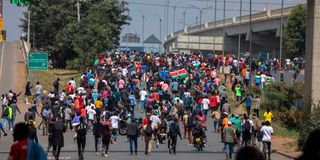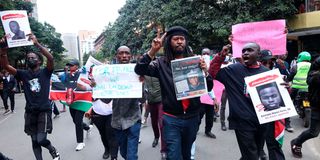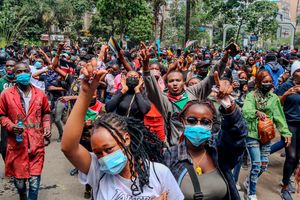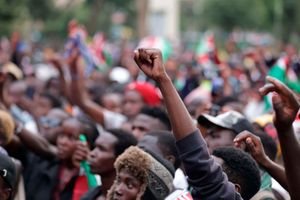
Demonstrators, mostly youths, at Uhuru Highway in Nairobi on July 23, 2024 during the Anti-Ruto demonstrations. The protesters have been on the streets, demanding good governance from National and County governments.
On June 25, 2024, a restless generation of young people armed with smartphones, flags and a rallying cry for justice stormed the gates of Parliament.
What began as digital outrage over the controversial Finance Bill, 2024 exploded into a nationwide revolt against government excesses, economic strain and broken promises.
The Bill, which proposed steep taxes amid a soaring cost of living, united a generation-long considered apathetic. But this time, they didn’t just scroll or post — they mobilised, taking their anger from screens to the streets.
Unlike traditional demonstrations, the Gen Z-led protests were organised without political parties, tribal affiliations or formal leadership. The young protesters harnessed social media to coordinate, educate and mobilise all without a single rally or politician at the helm.
With smartphones, placards and flags in hand, Gen Z painted Nairobi’s streets in bold protest. They ignored tribal lines, economic status, and political loyalties — replacing them with hashtags, songs, and solidarity.
Less than two years into President William Ruto’s reign, the youth declared they were done waiting. From TikTok to teargas, their message was clear: they wanted accountability, action, and dignity.

Members of the public protests in Nairobi on June 17, 2025 demanding justice for blogger Albert Ojwang who was killed in police custody at Nairobi’s Central Police Station.
Platforms like X, formerly Twitter, and Instagram swiftly became modern equivalents of the university forums of the past, where ideas were exchanged, and movements born.
The new generation was announcing its presence with social media and other digital platforms fuelling a wave of protests across the country rooted in widespread grievances against the government.
Rallying calls on social media, political messages on street walls and pavements, and defiant music became the modus operandi as the brave and articulate youth took over.
In Kenya, those under 35 years constitute about 80 per cent of the population, and of the 12 per cent of the population who are unemployed, more than two-thirds are the youth.
According to the 2019 Kenya National Bureau of Statistics census report, Kenyans under the age of 35 years stood at 13.7 million, roughly 29 per cent of the country’s 47.6 million people in the country at the time.
Educated, politically conscious, and tech-savvy, the scale of the protests was astounding. Anguka Nayo, a song by Wadagliz KE, became a soundtrack to Gen Z’s rallying cries against punitive government policies.
While mass protests are not new to Kenya, the form and organisation of the youth-led protests heavily relied on social media.
Kenya’s political history has been characterised by protests dating to the one-party autocracy and before, but the Gen Z-led protest was distinct.
Using technology as their strongest weapon, social media platforms helped in mobilisation — a marked departure from the past where money and night meetings were used. The youths’ turnout was organic.
With the clarion call of “nothing for us without us”, the digital natives heralded a new era of digital activism as they coordinated and mobilised on social media and other digital spaces.
They spread the word by sharing messages, pictures and videos on different social media platforms. Occupy Parliament and total shutdown hashtags and posters gained momentum with the reverberations of the protests drawing attention from neighbouring countries and beyond. Youth in Uganda and Nigeria, in particular, tried to replicate what was happening in Kenya.
For the first time, the youth cut ties with politicians and civil society as they took matters into their own hands.
Video snippets and AI-driven posts became prominent, buoyed by high internet connectivity in the country.

A man displays a placard with the picture of Deputy Inspector-General of Police Eliud Lagat during protests in Nairobi on June 12, 2025 to demand justice for Albert Ojwang who died in police custody.
Kenya’s internet connectivity rate is among the highest in the region. With 40 per cent of the population enjoying a connection that comes with an affordable mobile data subscription.
Even Zello, a push-to-talk walkie-talkie app, served as a real-time communication channel for coordinating movement.
The youth took the lead in educating, sharing information, and live-streaming the protests and their demands.
Unlike in the past when protests were organised by the political elite, sections of civil society, and trade unions; these ones were inspired by cross-cutting concerns about the sorry state of the Kenyan economy, unresponsive politics, as well as extrajudicial killings and enforced disappearances.
“This was unlike any other protests the country has witnessed because the mobilisation and organisation was digital. It had no politicians or old guards but was purely led by young people who knew what they wanted,” said Hanifa Adan, a journalist who rose to prominence as an activist in the protests.
“It started as something fun, fresh and proud, like I am doing something for my country. Everyone wanted to be involved. Even celebrities joined the movement unlike in the past. We had people creating Chat GPT for the Finance Bill, translating it into different vernacular languages,” added the 28-year-old.
She noted that social media and easy access to information became powerful tools for mobilisation, especially TikTok where people would validate each other when their friends posted videos of protests.
“The digital era made it easy to organise unlike before when people had to meet for mobilisation. No one wanted to be left out and that contributed to the mobilisation. People wanted to be in the moment and experience it as well,” said Ms Adan.
Activist Boniface Mwangi said: “With a press of a button, you are able to overcome gatekeepers. Social media has made it easy for Kenyans to protest and be heard.”
“Kenya has changed forever. In the past, protests had to be organised by politicians or activists, but today anyone can do a poster or a TikTok video about an issue and people will go to the streets,” he added.
“Anyone anywhere can organise a protest and it will have an impact because Kenya is no longer relying on their leaders to fight for them but themselves, Me Mwangi said.
Former Makueni Governor Prof Kivutha Kibwana said: “Current living conditions are also fuelling the protests and not social media alone, though it is an advantage in terms of mobilisation. The scale of the demonstrations in terms of numbers has been astonishing compared to the past.”
In a show of togetherness and comradeship, volunteer medics came out to provide onsite treatment for victims, some offered free legal aid services, while others crowdfunded for medical supplies and resources to clear bills for those injured during the protests.
The Korogocho-born Hanifa pointed out that the most outstanding thing about the Gen Z movement was the decentralised leadership where no one could come out and say they speak for the rest.

Protesters march along Kenyatta Avenue in Nairobi during anti-Finance Bill demos on June 25, 2024.
“It was unplanned, very raw and fuelled by simmering anger because the youth would complain but nothing was being done,” she explained.
Just like the way freedom fighters fiercely battled for the country's independence, the Gen Zs were united against a government that rode to power on their (read hustlers) backs with a myriad of promises of a better future, but soon turned against them once in swanky offices.
Opposition against the Finance Bill soon morphed into agitation against runaway corruption, a show of opulence by top State officers and soaring cost of living, which had become the emblem of the Kenya Kwanza government led by President Ruto and his then deputy Rigathi Gachagua. Mr Gachagua was impeached in October last year after an ugly fallout with his boss.
Despite the shootings of their colleagues by the police, the youth were undeterred — with the deaths only adding fire to their resistance.
“This government was elected on a popular mandate; it was supposed to be a hustlers’ government. They promised young people jobs but the youth are still unemployed and struggling to make ends meet. So the people realised the government lied to them,” said Mr Mwangi.
“Protests is the language of the weak and the oppressed who are looking for a way to be heard. They are showing their frustrations and pain.”
The simmering tension soon found its way to Parliament Buildings after members of the National Assembly had hurriedly passed the Finance Bill amid protests in the morning of that fateful June 25, 2024.
With police overpowered, they retreated in the face of surging protesters. Parliament’s gate was the first to give way, followed by the perimeter fence facing Intercontinental Hotel.
A police lorry was set on fire outside Parliament, as scores of protesters gained entry into the Senate and the National Assembly, leaving a trail of destruction in their wake.
The youth breached Parliament — accused of being enablers of the government through approval of repressive policies. And for the first time since the attempted 1982 Air Force coup, the government deployed the military on the streets of Nairobi.
Several protesters were shot dead inside Parliament. Their spilt blood only watered the germinating seeds of resistance across the nation.
For more than a month, Tuesdays and Thursdays were marked days, as normal operations were paralysed and the capital city was at a standstill due to relentless protests.
What started in Nairobi soon spread to other major towns in the country, with at least 31 counties making their voices heard —the country was on a precipice.
Presenting themselves as tribeless, partyless, leaderless; it was a hard nut to crack for the ruling class as the demonstrations were distinct from typical political protests. It became difficult for the government to target those behind the protests.
The State-funded Kenya National Commission on Human Rights reported that at least 60 people were killed during the protests between June and July last year, while more than 80 people were abducted in the six months to January 2025.
While President Ruto tried to put up a brave face, and at one point calling the protesters “criminals”, the Head of State was soon forced to eat humble pie. He gave in to the protesters and agreed to institute far-reaching reforms as demanded by the young people.
After persistently rejecting dialogue calls, the Commander-in-Chief was forced to reject the controversial Finance Bill, 2024 asking Parliament to withdraw it in its entirety.
“My good sons and daughters, let me tell you that I value what you do. I have heard what you have said, I have seen what you have done and you have made recommendations. Some, I will outrightly implement by cutting down on government wastages as well as on offices that we can,” President Ruto said.

Busia Senator Okiya Omtatah (center) with other protesters during the anti-abduction protests on Aga Khan walk in downtown Nairobi on December 30, 2024.
“I will deal with some of the issues you have raised. You have given me some difficult choices…. My request to you is that we have a country to keep. It is the only home we have...,” he added.
But sustained pressure continued as the Gen Zs came up with more demands they wanted to be addressed by the government.
Top of the list posted online and designated “non-negotiable" was the call for the Executive to obey all court orders and scrap the illegal and illegitimate Chief Administrative Secretary (CAS) position.
The President climbed down, he sacked his Cabinet and accepted the resignation of Inspector-General of Police Japhet Koome. The youth also called for the removal of public funding for the Office of the First Lady, Second Lady and Prime Cabinet Secretary’s Spouse. The President later accepted the demand and scrapped the budget.
But the post-Gen Z protests period has seen the State become more repressive. The wave of abductions peaked in December and January when AI-generated images showing the President in a casket were circulated on social media.
Despite the President’s apology to the youth during the National Prayer Breakfast last month, his regime is still perpetuating human rights violations.
The recent death of teacher Albert Ojwang’, 31, in police custody, and the continued killing of protesters is a worrying trend.
While some quarters had at first thought the Gen Z protests were just a passing moment in time, reality continues to sink in. The youth are back in the streets and are demanding far-reaching reforms. Increased police brutality has not succeeded in quelling the protests neither has infiltration by goons
The outcome of this digital uprising remains uncertain, but one thing is clear: social media has become an indispensable tool for political activism in Kenya and across Africa as the voices of Gen Z are resonating louder than ever.
The list also came with calls for the immediate firing of all government officials with criminal records and integrity issues while being advised to constitute the electoral agency within 30 days and employ junior secondary school teachers and intern doctors.
What followed was unprecedented. The President fired his Cabinet – coming up with a new-look Cabinet co-opting more youth in the government and a section of the Opposition, instituted austerity measures, State officers reduced their public display of opulence, among other measures.
The President promised better governance would follow after two months of a near collapse of his administration and a near-total shutdown of the economy.
The church also stood with the youth, giving them a platform to air out their views and eventually banning politicians from the pulpit.
But the post-Gen Z protests period has seen the State become more repressive amid rising cases of extrajudicial killings, police brutality, abductions and enforced disappearances.
The wave of abductions peaked in December and January when AI-generated images showing the President in a casket were circulated on social media.
Despite the President’s apology to the youth during the National Prayer Breakfast last month, his regime is still perpetuating human rights violations.
“To our children, if there has been any misstep, we apologise,” the President told the country’s young people.
The recent death of Albert Ojwang’, a 31-year-old teacher, in police custody and the continued killing of protestors by the police, continue the worrying trend.
While some quarters had at first thought the Gen Z protests were just a passing moment in time, reality continues to sink in.
The youth are back in the streets and are demanding far-reaching reforms. Increased police brutality has not succeeded in quelling the protests as well as infiltration by the goons have had no success.
Social media has now become a potent tool for young Kenyans, a platform they continue to exploit to express their discontent, hold their governments accountable, raise awareness about injustice and corruption, and resist authoritarianism.
Digging into the digital trenches, the smartphone is now a powerful weapon for the youth with increased internet access widening their democratic spaces, providing a fertile ground for digital activism to flourish.
Though the protests have reduced in size and geographic spread since June 25, 2024; regular countrywide protests are still ongoing as frustrations continue against the current tone-deaf regime.
The young people are determined to ensure their voices are heard, both online and offline; leveraging on the power of social media to amplify their voices, challenge the status quo and demand a better future for their country.
The outcome of this digital uprising remains uncertain, but one thing is clear: social media has become an indispensable tool for political activism in Kenya and across Africa as the voices of Gen Z are resonating louder than ever.









